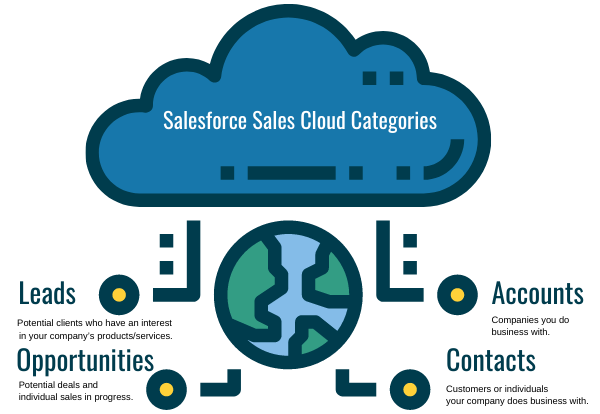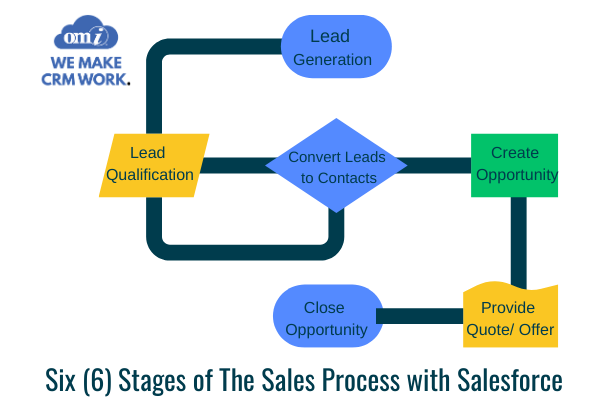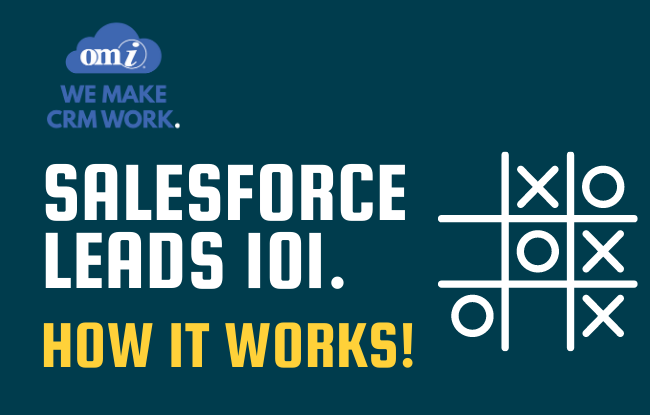When it comes to an efficient marketing strategy, leads are what should come first to your mind. Assigning your leads, accounts, contacts, and opportunities properly is the basis of your future success. To make sure a company tracks its prospects the right way and converts as many leads as possible into real business opportunities, we’ve decided to provide you with detailed information on these Salesforce categories and explain why leads always come first.
What Leads in Salesforce Means
Salesforce Leads is a category of people that have no purchase history but who have an interest in your company’s products or services. Leads have contact information allowing sales representatives to reach them out and see whether your organization can cover these potential clients’ needs. This process is called lead qualification. At some point, some leads can be converted into Contacts for discussing your offer while those who don’t qualify will be removed from the Salesforce Current Leads list.
There are numerous lead generation techniques that can bring potential customers. Leads can be:
- People you’ve met during exhibitions, sales trades, business meetings, etc.
- Cold contacts you need to reach out to see whether they are interested in your company’s services/products.
- Your company’s website visitors who filled out an online contact form.
- People who saw your marketing campaign and got in contact with your company and many others.
If your marketing team works well, there will be many leads generated every day. Salesforce helps to sort them out and focus only on those people who will bring profit to your company. No matter what lead generation technique you use, every new person that goes in contact with your company’s representative but is not working with or purchasing from your company should be assigned to Salesforce as a lead.
Salesforce Lead Statuses
It’s safe to say that the lead status field is one of the most crucial information fields in all of Salesforce – this is what drives your sales process. By default, Salesforce offers 4 lead status options: Open, Contacted, Qualified, Unqualified. And although these are perfectly fine and functional options, many companies choose to customize them and tailor them to their specific needs. Here are some of the more common examples of custom lead statuses:
- Raw – people in your database who you know but who aren’t ready for sales yet; it is the responsibility of marketing to pique these leads’ interest and persuade them to perform an action that shows they may be ready for the sales process;
- Working – people that are being contacted by the sales team and are in the process of qualification; they should be managed with the help of a sales engagement tool and with a set amount of sales activities over a set amount of time;
- Nurture – people that are qualified by your sales team, but are not currently in the buying cycle; it is recommended to keep “nurturing” them by keeping their interest warm.
Salesforce Opportunity, Contact, and Account: What’s the Difference?
What about other categories in Salesforce? Let’s cover them one by one.

Salesforce Contact
Salesforce Contact are typically considered equivalents of qualified leads. It is someone who has been engaged in communication with your team, hence, their contact information is in your database. Usually they are representatives of an organization you are trying to get as your client, but they may as well be a referral partner.
Salesforce Account
On the other hand, a Salesforce Account is not a person, but rather a business entity you’re attempting to sell your products/services to. It’s quite common that there are more than one contacts for each account, because during the course of a sales cycle you sometimes get to engage with multiple representatives of one organization.
Salesforce Opportunity
Lastly, a Salesforce Opportunity shouldn’t really be seen as either a person or a business, it’s more of a representation for a potential sale. You normally convert a lead into an opportunity when you feel there is a high chance of closing a deal and making money.
This is what the sales process looks like in the case with Salesforce:

As soon as you convert your lead to contact in Salesforce, this person becomes your customer and you can make your offer to cover his/her needs. Once you agree on the deal, you store the information on your potential sales in Opportunity until the deal is closed.
Salesforce Leads vs. Opportunities
With all of this in mind, it’s not rare for people to confuse leads and opportunities, so it’s crucial that you understand the very obvious distinctions between the two.
A lead is an unqualified contact who has the potential to become a paying client. Leads are discovered during the first contact stage of the sales cycle, and they cannot be utilized to predict upcoming sales.
On the other hand, an opportunity is essentially a conversion in progress. The phases of the sales cycle known as quotes, proposals, and, finally, orders are when you start talking about your prospects as opportunities. And as opposed to leads, opportunities can and should be leveraged to project future sales.
Salesforce Leads vs. Contacts
In the same manner, let’s take a look at the main difference between a lead and a contact.
When dealing with Salesforce, consider a contact as a qualified lead. In other words, as the lead that has been contacted, engaged in communication, and interested in the goods or services offered by your business. A contact is someone who is more likely to make a deal than a lead is.
How To Convert A Lead Into An Opportunity, Contact, Or Account
As you might have realized by now, a lead predates a contact, an opportunity as well as an account. That means, at some point of the sales cycle we’ll need to convert a lead into one of those three – and doing that is very easy. To convert leads, use the Convert Lead page.

Salesforce uses the data you previously entered into the lead record to automatically fill out related fields in the contact record when you convert a lead. From this screen, you can create an account, a contact or an opportunity from a lead by simply entering (or using pre-filled) an account/contact/opportunity name and clicking “Convert”.
Reasons To Use Salesforce Leads
There is basically one big reason why you want to utilize Salesforce Leads – it makes your sales process so much more organized. And if we try to break this into a couple of more specific reasons, we may highlight the following:
Improved Lead Qualification
Long-term time savings come from using Leads, which let you find and engage people who are really interested in your goods or services. Leads can occasionally be brand-new Contacts at active Accounts. In other cases, Leads are added to your database via a marketing automation tool or a web-to-lead form. Either way, maintaining a clean database is essential, as is controlling duplicate records and new system entries – it’s not uncommon for teams to contaminate their “leads” with qualified Contacts, which prevents them from segmenting and nurturing real leads.
Improved Marketing ROI Tracking
For example, one marketing tool that illustrates how well Leads are converted into real, active Contacts and Opportunities is Salesforce Campaigns. Using the capabilities of the tool, you can enter the cost of marketing activity and evaluate it against the return. These ROI measures can help them set priorities for their resources and prevent spending money on ineffective channels.
Improved Buyer Journey Tracking
Lead object-driven Salesforce lifecycle reports rely on building a multi-stage customer journey to fully depict pipeline performance. You may adjust your lead nurturing and lead qualification strategies with Salesforce reports by leveraging targeted data that shows potential drop-off or momentum points for leads.
Salesforce Functionality Used to Manage Leads
Salesforce offers numerous features and functionality to help you manage your lead the right way and take maximum advantage of their qualification. For instance, Salesforce allows assigning different leads to different managers depending on their initial interest in products or services, region, and other criteria. Salesforce also makes sure there are no duplicate leads in the system which can happen sometimes when leads are generated by several different managers at the same time. Duplicate contacts can be merged while existing ones can be easily updated with new information.
The automated feature allows converting a lead into contact without any manual data entry which decreases the risk of human errors. You can also generate the Leads and Contacts report in Salesforce to analyze the given data and see whether your marketing team performs well.
A Set of Basic Rules to Work With Leads in Salesforce
Set time limits. Freshly generated leads need to be contacted ASAP. The best practice is to contact a lead within 5 minutes of the initial inquiry. If this is not possible use automated email responses defining when someone will contact the lead and follow up on the timeline defined. Salesforce offers a simple web to lead HTML form that can be used to capture and assign leads by priority to the sales team. All Leads should be prioritized and contacted the same day as a general rule of thumb. Leverage Salesforce lead queue assignments to ensure all leads are assigned to the right representative and never sit in limbo.
Assign your leads to three main categories. Each lead can be assigned to only one of these categories: Contacted, Qualified, and Not Qualified. Sales representatives are the ones who reach out to potential clients and decide to which category a lead will be assigned.
Don’t forget about follow-ups. Reminding your customers about your company is important. Make sure you use Salesforce to assign a follow-up task to speak with your potential client later. Maybe the next time you call you’ll agree on a deal.
Set our Opportunity standards. The goal of every sales manager is to convert leads into real sales as soon as possible. Salesforce allows converting Leads into Opportunities skipping the “convert to Contact” stage. However, it’s important for a company to set certain rules and standards when a sales rep can and should create an Opportunity.
Taking Maximum Advantage of Salesforce Leads
Salesforce is a powerful tool that helps to take your company’s existing processes to the next level. If you are looking for an opportunity to introduce Salesforce to your business infrastructure, reach out to OMI specialists. With over 20 years of Salesforce experience, our team knows exactly how it’s best to implement and customize CRM software in accordance with the specific business needs and goals.
